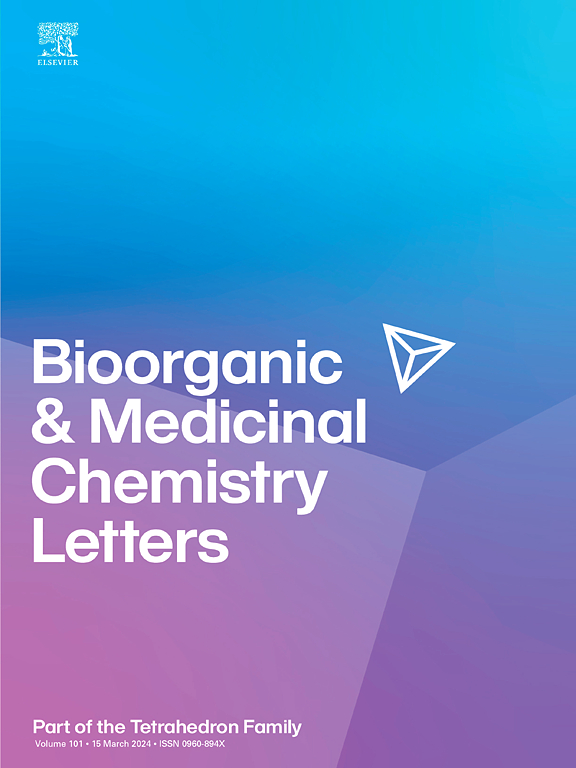Discovery of novel fusidic acid derivatives in mitigating LPS-induced acute liver injury by modulating RIPK1
IF 2.2
4区 医学
Q3 CHEMISTRY, MEDICINAL
引用次数: 0
Abstract
Inflammation plays a crucial role in the onset and progression of sepsis, affecting the overall trajectory of the condition. Additionally, sepsis can result in acute liver injury, which in turn may cause damage to multiple organ systems. Fusidic acid (FA) is a natural product with a steroidal structure and has good anti-inflammatory activity without the hormonal side effects of steroidal anti-inflammatory drugs, so it has potential applications in the development of anti-inflammatory drugs. In the present study, a series of novel FA derivatives were designed and synthesized by structural modification of FA C-3, C-16 and C-21, among which, compound 12 exhibited the strongest anti-inflammatory activity. Compound 12 inhibited nitric oxide (NO) release with an IC50 of 3.26 ± 0.12 μM. Assessments conducted in both in vivo and in vitro settings indicated that compound 12 can reduce the levels of inflammatory factors, inhibit the activation of inflammatory pathways and improve liver pathological damage. Cellular thermal shift assay showed that compound 12 had binding ability with receptor interaction protein kinase 1 (RIPK1). Furthermore, through the western blotting experiment, this study found that compound 12 inhibited proteins such as RIPK1, p-IκB, p-p65, p-p38, p-JNK and p-ERK within the RIPK1/nuclear factor-κB (NF-κB)/mitogen-activated protein kinases (MAPK) signaling pathway. Concurrently, ELISA experiments indicated that compound 12 could dose-dependently reduce the levels of IL-6 and TNF-α. These results imply that compound 12 can protect the liver from inflammatory invasion by suppressing RIPK1 expression, which subsequently results in decreased activation of the NF-κB and MAPK signaling pathways. In this study, we creatively modified the structure of fusidic acid and obtained a new type of fusidic acid derivative 12. Compared with the glucocorticoids currently used for glucocorticoid receptors, compound 12 is novel in terms of structure and mechanism of action in alleviating sepsis. Our research indicates that compound 12 represents a promising candidate for the design and development of anti-sepsis therapeutics.

发现新的夫西地酸衍生物通过调节RIPK1减轻lps诱导的急性肝损伤。
炎症在脓毒症的发生和发展中起着至关重要的作用,影响着病情的整体发展轨迹。此外,败血症可导致急性肝损伤,进而可能导致多器官系统受损。氟西地酸(FA)是一种具有甾体结构的天然产物,具有良好的抗炎活性,且没有甾体类抗炎药的激素副作用,在抗炎药物的开发中具有潜在的应用前景。本研究通过对FA C-3、C-16和C-21进行结构修饰,设计合成了一系列新的FA衍生物,其中化合物12的抗炎活性最强。化合物12抑制NO释放的IC50为3.26 ± 0.12 μM。体内和体外实验表明,化合物12可以降低炎症因子水平,抑制炎症通路的激活,改善肝脏病理损伤。细胞热移实验表明化合物12 与受体相互作用蛋白激酶1 (RIPK1)具有结合能力。此外,通过western blotting实验,本研究发现化合物12抑制RIPK1/核因子-κB (NF-κB)/丝裂原活化蛋白激酶(MAPK)信号通路中的RIPK1、p- i -κB、p-p65、p-p38、p-JNK和p-ERK等蛋白。同时,ELISA实验表明,化合物12能剂量依赖性地降低IL-6和TNF-α水平。这些结果表明,化合物12可以通过抑制RIPK1表达来保护肝脏免受炎症侵袭,进而导致NF-κB和MAPK信号通路的激活降低。在本研究中,我们创造性地修饰了福西地酸的结构,得到了一种新型的福西地酸衍生物12。与目前用于糖皮质激素受体的糖皮质激素相比,化合物12在减轻脓毒症的结构和作用机制上都是新颖的。我们的研究表明,化合物12是设计和开发抗败血症治疗药物的一个有希望的候选者。
本文章由计算机程序翻译,如有差异,请以英文原文为准。
求助全文
约1分钟内获得全文
求助全文
来源期刊
CiteScore
5.70
自引率
3.70%
发文量
463
审稿时长
27 days
期刊介绍:
Bioorganic & Medicinal Chemistry Letters presents preliminary experimental or theoretical research results of outstanding significance and timeliness on all aspects of science at the interface of chemistry and biology and on major advances in drug design and development. The journal publishes articles in the form of communications reporting experimental or theoretical results of special interest, and strives to provide maximum dissemination to a large, international audience.

 求助内容:
求助内容: 应助结果提醒方式:
应助结果提醒方式:


